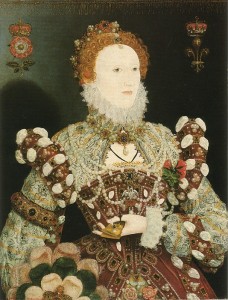Henry VIII spent the last days of Anne Boleyn’s confinement trying to decide whether to call his son Edward or Henry. Though in the end neither was of use to him as the child born was a girl.
On Wednesday 10th September 1533, a magnificent christening was held at the church of the Observant Friars. The Church was some distance from the main palace of Greenwich and had also been the setting of Henry VIII’s christening.
The location in itself was a final blow to those hostile to the king’s new marriage as it had been the centre for the most public opposition to the divorce.
A great silver font was brought from Canterbury and placed on a large octagonal stage inside the church. The font was lined with soft linen to ensure that the metal did not harm the royal baby and the stage was covered with red and blue cloth. The west doors through which the procession would enter were hung with cloth of gold.
Starkey describes the ceremony in detail:
The heralds carried their tabards. Attendants and serving men bore unlighted torches. Lords and ladies carried the equipment needed for the ceremony: a gold cellar of salt, for the exorcism of the child; great silver gilt basins in which the godparents could wash off traces of the holy oil with which the child was anointed; a chrisom-cloth, to be bound over the crown of the baby’s head after she had been anointed with chrisom; and a taper, to be lit after the baptism was completed. Elizabeth herself was carried by a duchess, and her long train by three peers and peeresses of the royal blood. Four barons carried a canopy over her. She was christened by the Bishop of London, and the Archbishop of Canterbury was her godfather. Three times the baby was plunged in the waters of the font. Then the lighted taper was thrust in her hand. At this moment, all the torches were lit; the heralds put on their tabards and the trumpets rang out in honour of Elizabeth, Princess of England and of France (Starkey, pg. 4).
The child was named Elizabeth to remind all of her undisputable royal connection. I’m sure this would have pleased Anne, as not only was Henry’s mother named Elizabeth but her own mother as well.
There were 21 participants listed by Edward Hall. Ives identifies the Boleyns and Howards as:
Anne’s father and brother and eight Howard connections, Thomas Cranmer (as godfather), one person who was linked to William Brereton and another to Thomas Cromwell (Ives pg. 185).
The duke of Suffolk escorted Elizabeth; the marquis of Exeter carried the taper of virgin wax; John, Lord Hussey, helped carry the canopy and the marchioness of Exeter was one of the godmothers. Strangely enough, Lord Hussey was Lady Mary’s chamberlain and the marchioness of Exeter a supporter and friend of Katherine of Aragon. She had only agreed to take part in the ceremony to avoid facing the wrath of the king (Ives, pg. 185).
The godparents, Archbishop Cranmer, the Dowager Duchess of Norfolk, the Dowager Marchioness of Dorset and the Marquess of Exeter, then presented Elizabeth with gifts and refreshments were served.
The procession, escorted by over 500 torchbearers, then returned Elizabeth to the Queen’s Apartments. There ‘Anne, robed and lying on her great French bed with the King at her side, received her daughter joyfully, and offered the guests more refreshments’ (Weir, pg. 259). The French noted that ‘the whole occasion was so perfect that nothing was lacking ‘ (Ives, pg. 185).
Of course there was one thing lacking – a son. The sex of the baby was not what anyone had hoped for. Henry and Anne were putting on a brave face but the truth remained, Anne had promised the king a son and heir and the royal astrologers and physicians had predicted a boy but both had failed.
An embroidered satin gown traditionally thought to have been worn by Elizabeth I at her Christening is on display at Sudeley Castle. The gown is exquisite and in excellent condition, however, it is now believed to have been made in the 17th century.
References
Ives, Eric. The Life and Death of Anne Boleyn, 2004.
Starkey, David. Elizabeth: The Struggle for the Throne, 2001.
Weir, A. The Six Wives of Henry VIII, 2007.

















The irony of the whole thing was – we know now it is the Father’s sperm which dictates the gender of the offspring. That – and of course – the fact that Elizabeth was one of the most memorable Monarchs ( along with her Father).
Hi!
Once i read that Anne wanted Mary’s christing gown to Elizabeth’s, but Henry didnt allow because it was Catherine’s. Also, that Anne wanted to name Elizabeth “Mary” in a way to overshadow her stepdaughter. Do you know anything about it?